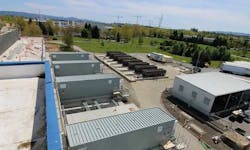Subsea Cables, Tech Workforce Boost Portland Data Center Market
A new special report from Data Center Frontier explores the evolution of the Portland, Oregon data center market. This second entry in a DCF article series explores technology in the area — the region’s competitive advantage, and a breakdown of the mass of subsea cables that provide global access in the area.
Get the full report.
The Portland data center market benefits from the active technology cluster in the emerging data center district in Hillsboro, which offers favorable economics and ready access to fiber rings that connect facilities to trans-Pacific subsea cables that land on the Oregon coast, enabling data traffic to fast-growing markets around the Pacific Rim.
Compared to the U.S. average, the Portland suburb of Hillsboro has 3 to 5 times the concentration of engineering jobs and twice as many computer jobs. Technology services is Hillsboro’s fastest growing trade sector industry.
The anchor of the Hillsboro market is Intel, which employs 21,000 high-tech workers across four campuses. The chipmaker has invested more than $43 billion in its Hillsboro presence, which has been a magnet for other technology firms. A semiconductor supply chain cluster is being created that includes firms like NVIDIA, Applied Materials, Qorvo, and Thermo Fisher Scientific.
Other technology firms who have a presence include Adobe, Comcast, Salesforce and LinkedIn, all of whom have data center operations in Hillsboro.
At the state level, Oregon gained momentum as a data center market when it capitalized on lapsed data center tax incentives in Washington State in 2011. That was when Infomart and Digital Realty arrived, while Facebook’s deployment of a huge campus in Prineville in 2011 further highlighted Oregon as a destination for data centers.
Oregon’s Competitive Regional Advantage
The data center competition between Washington and Oregon was examined in a 2018 analysis by the Washington State Department of Commerce, which documented the slowing growth in Washington’s leading data center clusters in Seattle and Quincy/Wenatchee.
“Since 2013 virtually all data center site locators looking for an urban location (in the Pacific Northwest) ultimately arrive at a Hillsboro versus Seattle decision,” the study says. “Because of the sales tax differential between them, the deal flow overwhelmingly favors Hillsboro. As a result, the Seattle data center market now has an 18.8 percent vacancy rate and is underperforming on absorption.
“The Portland metropolitan area has become the go-to regional hub for urban data centers in the Pacific Northwest while growth in urban western Washington has languished,” the analysis found. “As a result, Oregon has won approximately a billion dollars in positive economic outcomes.”
The detailed study found that the key differentiator between the two markets is that the sales tax applied to data center equipment purchases and deployments results in a 10 percent cost advantage for Hillsboro.
The data center sub-market in Central Washington is focused on Quincy. The tiny farming town in central Washington is home to a cluster of data centers, including several cloud campuses operated by Microsoft. Quincy is not for everyone, however. Several single-tenant facilities have thrived in Quincy, but multi-tenant service providers have a more mixed track record.
Quincy and neighboring Wenatchee offer cheap hydro-powered energy and an environment ideal for the use of fresh air in data center cooling systems, which allows facilities to operate without energy-hungry chillers. But the region lacks major universities or other technology industries that can provide a steady supply of skilled local labor, which is a common trait of most major data center markets. As a result, the area has been most attractive to tenants that run huge, highly-automated compute farms, including hyperscale operators (Quincy) and cryptocurrency miners (Wenatchee).
The Portland market has emerged as an attractive alternative, offering many of the same advantages as the Central Washington cluster—affordable green power and cool climate—along with tax incentives and an existing technology workforce.
A Critical Mass of Subsea Cables Provide Global Access
Another key differentiator for Portland is the Hillsboro cluster’s direct access to seven subsea telecommunications cables, which offer high-capacity connectivity to China, Taiwan, Japan, Korea, Guam, Hawaii, New Zealand, Australia, and American Samoa.
These cables come ashore in Pacific City, Oregon and tie into a dark fiber network from Wave Business that serves six data centers in Hillsboro. A second phase of the Wave fiber ring will be completed in the second quarter of 2020, connecting an additional eight data center locations to the cable landing station.
The Hillsboro cluster can offer customers easy access to Asia-bound data traffic, an option which is not available in markets in interior states (such as Nevada and Arizona) that are also competing for California customers.
The data center business is increasingly a global business, with cloud providers and multi-national enterprises seeking to create data-centric businesses that can span continents. Subsea cables are now a strategic asset for hyperscale customers, who often make direct investment in new cables. Amazon (Hawaiki), Microsoft (New Cross Pacific) and Google (FASTER) are investors or major users for cables that land in Pacific City.
Asia is a major growth market for cloud platforms and service providers seeking to expand in China, India, Australia and other Pacific Rim nations. The Hillsboro cluster can offer customers easy access to Asia-bound data traffic, an option which is not available in markets in interior states (such as Nevada and Arizona) that are also competing for California customers.
That’s one reason that data center developers are investing in Portland for new capacity.
Explore the Portland data market further through Data Center Frontier’s special report series over the next few weeks and ongoing coverage of the growing colocation industry in the Pacific Northwest region. Next up, we will cover supply trends and the general business environment. And catch the first in the series below:
And see the full report,“2020 Data Center Market Overview Portland.”
About the Author



